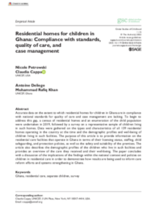Accurate data on the extent to which residential homes for children in Ghana are in compliance with national standards for quality of care and case management are lacking. To begin to address this gap, a census of residential homes and an enumeration of the child population were undertaken in 2019, followed by a survey on a representative sample of children living in such homes. Data were gathered on the types and characteristics of all 139 residential homes operating in the country at the time and the demographic profiles and well-being of children living in such facilities.
The purpose of this article is to provide information on the residential care facilities that operate in Ghana in terms of their licensing status, staffing, child safeguarding, and protection policies, as well as the safety and suitability of the premises. The article also describes the demographic profiles of the children who live in such facilities and provides an overview of the care they received and their well-being. The paper concludes with a discussion of the implications of the findings within the national context and policies on children in residential care in order to demonstrate how results are being used to inform care reform efforts and systems strengthening in Ghana.
Related:
- Factors Associated with the Family Reintegration Stability for Children with a Residential Care Experience in Ghana
- The Role of Resilience Processes in Education and Well-Being Outcomes for Separated Children in Uganda: Exploring Street-Connected Children’s Pathways Through a Resilience-Based Programme and Beyond
- Intersectional Yet Individual Experiences: The Importance of Acknowledging, Conceptualising and Contextualising Separated Childhoods
- The Critical Intersection Between Child Reintegration and Community Connectedness: An Experience from Guatemala
- Beyond Family: Separation and reunification for young people negotiating transnational relationships

